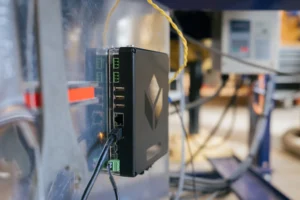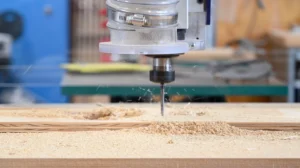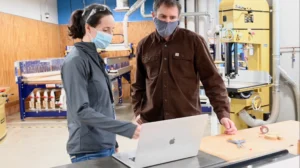
Unlocking Insights with Simple Sensors and Machine Learning at the Autodesk Technology Centers, Boston
For Josh Aigen, Workshop Supervisor at the Autodesk Technology Centers Boston, learning is part of the job. Josh manages and oversees the shared woodshop and laser cutting shop that Autodesk Technology Centers provides to innovative organizations and teams, and ensures that everyone who uses the equipment is properly trained.
The amount of analog and custom equipment in their shop, like most, makes it complicated at times to gain insights into the performance of their operations and make improvements. Partnering with Tulip, Josh and his team have built automations and processes to ensure that they not only have insight into their shop but can notify the right people if something needs attention. For example, if a dust collector fills up, Tulip captures this event and triggers an email alert to notify someone that it is time to change the bin.
As the Tulip team began to build the next-generation edge device, the Edge IO, the Autodesk Technology Centers, Boston was a perfect spot to test new capabilities.

Analog Sensor Monitoring with the Edge IO
The Edge IO introduces high-speed analog monitoring capabilities with supported off-the-shelf current and vibration sensors. This brings new data into Tulip for analog machines. During the development of the Edge IO, the Tulip team connected an Edge IO to a stranded (non-networked) CNC mill.

An off-the-shelf, vibration sensor and current clamp were connected to the machine. The vibration sensor is connected to the chassis of the mill, and the current clamp is connected directly to the power supply cabinet.
Edge IO has Node-RED onboard, a flow-based programming language for connecting devices and sensors. On the device, data from the sensors passes through Node-RED and into the Edge IO, where it can then be sent and used in the cloud with Tulip apps. Tulip supplied flows make it easy to set up Node-RED for a specific sensor.
Enter Machine Learning
Once the solution was deployed, data was captured on the device, processed and visualized in Node-RED, and sent to Tulip to be used in no-code apps. The sensor data can be visualized in frequency and time-series graphs that show a machine’s behavior in real-time.
The Edge IO’s support for this high-speed monitoring combined with Node-RED, made it easy to unlock new insights into previously stranded machines.
Not only can operators have a live view of the machine’s performance, but the data can also be used to train machine learning models to predict the state and health of the machine.
As a tool wears out, the machine status can change, sending an alert. The Tulip team deployed a simple modal and app that can detect anomalies on the CNC mill and alert an operator visually in the app.
Empowering New Users
“We’re excited for training for new users with edge technology. We teach a lot of people here. The idea of machine learning helps us to better address the folks who don’t have the same level of experience that we have.” – Josh Aigen (Workshop Supervisor, Autodesk Technology Centers, Boston.)
At the Technology Center in Boston, Josh Aigen teaches a lot of people. Some new users that come through don’t have the same experience levels as others, and being able to use technology at the edge to assist them is a huge win. Anomaly detection powered by machine learning creates a feedback loop that is great for new users to overcome the steep learning curve that often accompanies these new machines.

The Autodesk Technology Centers are able to leverage Tulip to build exciting use cases with the scalability and agility of the AWS cloud to deploy apps for monitoring equipment usage and managing training. Tulip’s platform with connected edge devices and sensors provides a look into their operations, with actionable data accessible anywhere in the world.



